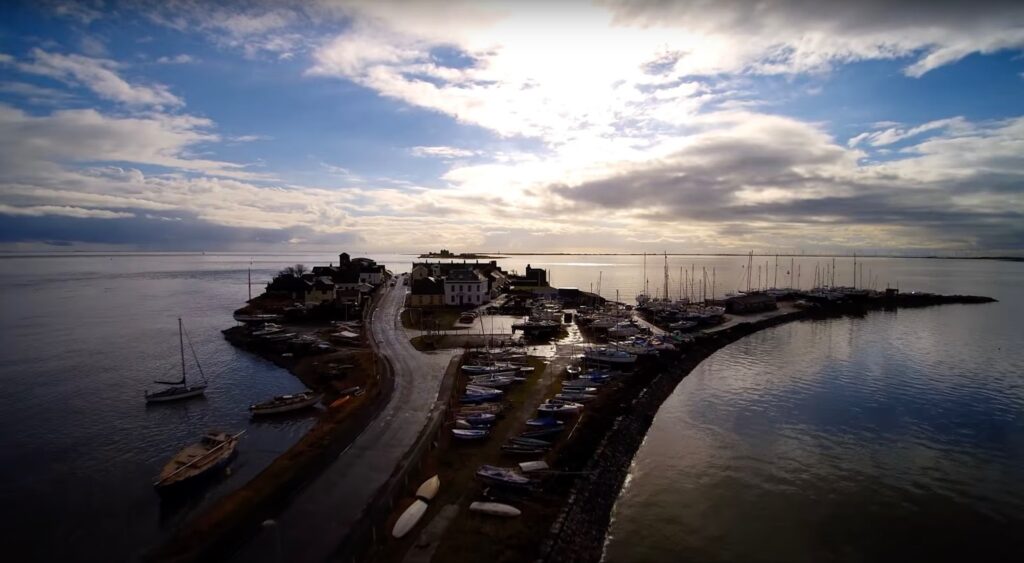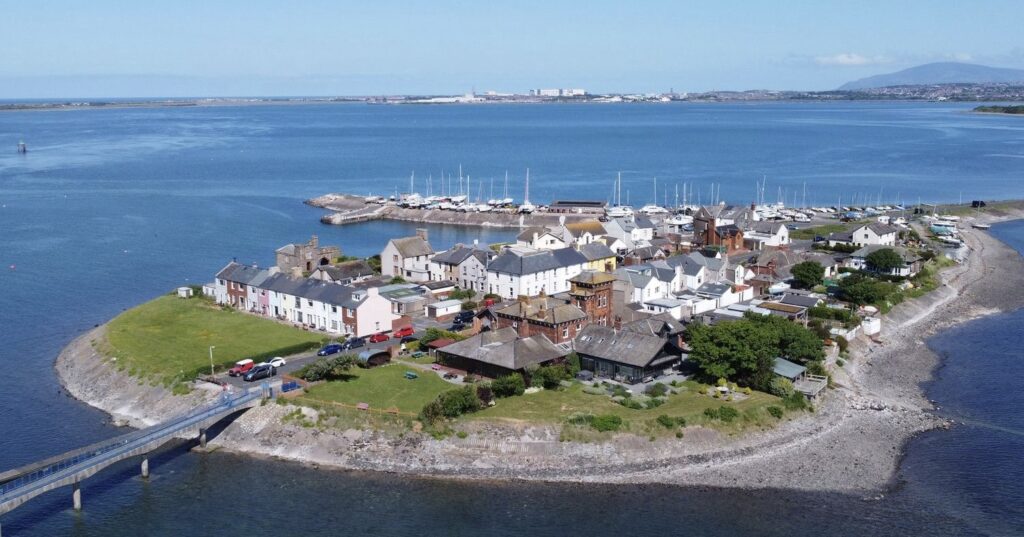Roa Island, a small yet fascinating piece of land located at the southernmost tip of the Furness Peninsula, beckons travelers with its unique blend of history, nature, and serenity. Once connected to the mainland by a causeway, this island encapsulates an intriguing mosaic of past and present.
A Journey Through Time: Roa Island’s History
Roa Island, despite its modest size, boasts a rich tapestry of historical tales. In the early 19th century, the island functioned as a base for shipbuilding and repairs, with vessels docking at its shores for expert craftsmanship.
The echoes of the island’s storied past can still be heard:
- Shipbuilding Era: In the early 1800s, Roa Island was a bustling hub of shipbuilding. Craftsmen and workers thronged its shores, working diligently on impressive vessels that would eventually sail the high seas;
- Piel Ferry: For centuries, the ferry from Roa Island to nearby Piel Island has operated, providing an essential link and further embedding Roa’s maritime significance.
Natural Splendors: Flora and Fauna
Roa Island’s location provides a natural haven for a wide array of species. The intertidal zones, mudflats, and surrounding waters offer diverse habitats:
Bird Species Found on Roa Island:
| Common Name | Best Viewing Season |
|---|---|
| Oystercatcher | Spring and Summer |
| Curlew | Winter |
| Redshank | All year round |
| Dunlin | Spring |
Mammals and Marine Life:
- Seals: Often spotted lounging on the rocky outcrops during low tide;
- Porpoises: Sightings are common around dawn or dusk, especially during spring.
Roa Island’s Architectural Marvels
The island is not just about natural beauty; its architectural marvels, like the quaint Victorian houses and the historic Roa Island Hotel, add to its charm. These structures serve as silent storytellers, giving glimpses into the island’s evolving lifestyles.
Activities and Attractions for Visitors
The range of activities Roa Island offers ensures every visitor finds something to their liking:
- Water Sports: Kayaking, paddleboarding, and sailing are popular among adventure enthusiasts;
- Historical Tours: Delve into the island’s past with guided tours, exploring everything from the old shipyards to the Victorian-era structures;
- Gastronomic Delights: Local seafood dishes, especially the Roa Island oysters and fresh fish curries, are a must-try for food aficionados.

Visiting Roa Island: Tips and Tricks
Planning a trip to Roa Island? Here’s everything you need to know to make your visit unforgettable:
Best Times to Visit:
While Roa Island is beautiful year-round, the months between April and September are particularly delightful. The weather is pleasant, and you’ll get to witness a vibrant mix of flora and fauna. However, if you’re an avid birdwatcher, winter months might offer sightings of migratory species.
Accommodation Options:
The island boasts a range of staying options, from the historic Roa Island Hotel that offers a blend of comfort and history to quaint bed and breakfasts run by locals. If you’re looking for an immersive experience, consider staying in a local homestay.
Travel Essentials:
- Clothing: Given its coastal location, it’s advisable to pack layers. Even in summer, evenings can be breezy;
- Footwear: Comfortable walking shoes are a must, especially if you plan on exploring the island on foot;
- Miscellaneous: Binoculars for birdwatching, a sturdy reusable water bottle, and a camera to capture the breathtaking vistas.
Local Etiquette:
Respect the island’s serenity. Roa Island is a tight-knit community, and locals appreciate visitors who tread lightly, both environmentally and culturally.
Roa Island’s Future: Sustainable Tourism
Roa Island is more than just a travel destination; it’s a delicate ecosystem and home to a rich tapestry of history and culture. As its allure draws increasing numbers of tourists, the emphasis on sustainable tourism intensifies.
Eco-Conscious Activities:
Many local businesses have pivoted to offering eco-friendly activities. Whether it’s guided nature walks that emphasize minimal disturbance or kayak rentals that promote clean water sports, Roa Island is making strides in green tourism.
Waste Management:
The community is proactive in waste management, with several initiatives promoting recycling and reducing single-use plastics. As a visitor, you can contribute by ensuring you dispose of waste correctly and minimizing your plastic consumption.
Supporting Local Economy:
The island’s local artisans and vendors offer a plethora of handcrafted goods and fresh produce. By choosing to shop local, you’re not only getting an authentic souvenir but also aiding in sustaining the island’s economy.
Educational Initiatives:
To further the cause of sustainable tourism, many local organizations host workshops and seminars. These sessions educate visitors about the island’s unique biodiversity, the challenges it faces, and how one can be a responsible tourist.

The Maritime Connection: Roa Island and Torpenhow Cumbria
Torpenhow Cumbria, situated inland from Roa Island, holds its own charm, and there’s an intriguing maritime connection between the two. Torpenhow, with its rolling landscapes and serene beauty, offers a contrast to the coastal allure of Roa Island. Here’s how they’re intertwined:
Historical Trade Routes:
Centuries ago, the region surrounding Torpenhow was an integral part of trading routes. Goods from the hinterlands would often be transported to coastal areas like Roa Island for further distribution or shipment.
Shared Cultural Festivities:
Both regions celebrate certain maritime festivals, paying homage to their seafaring ancestors. Participating in these events gives one a sense of the shared history and culture.
Roa Island and Torpenhow Cumbria:
| Feature | Roa Island | Torpenhow Cumbria |
|---|---|---|
| Landscape | Coastal | Inland, hilly |
| Popular Activities | Water sports, birdwatching | Hiking, historical tours |
| Local Delicacies | Seafood | Farm-fresh produce |
The Culinary Landscape of Roa Island
An essential part of any travel experience is indulging in local cuisine, and Roa Island doesn’t disappoint:
- Seafood Galore: Given its location, seafood is a staple. From freshly caught fish to shellfish, there’s a variety for every palate;
- Traditional Desserts: While seafood takes center stage, don’t miss out on the island’s traditional desserts. ‘Roa Pie’, with its flaky crust and sweet filling, is a must-try;
- Local Brews: Quench your thirst with local ales and ciders, which capture the essence of the island in every sip.
Conservation Efforts on Roa Island
The community of Roa Island is acutely aware of its responsibility to protect its natural habitats and species.
- Wildlife Sanctuaries: Areas of the island are designated as wildlife sanctuaries, ensuring minimal disturbance to nesting birds and other species;
- Clean-up Drives: Regular beach clean-up drives are organized, ensuring the shores remain pristine and safe for marine life;
- Educational Campaigns: Locals and authorities alike invest in campaigns educating visitors about the importance of conservation, ensuring that Roa Island remains a paradise for generations to come.
Conclusion
Roa Island, with its unique blend of history, natural beauty, and vibrant culture, offers an enchanting escape from the mundane. It’s a place where every corner tells a story, waiting to be discovered by those who seek the extraordinary.
FAQs
Summer and early autumn are ideal for warm weather and wildlife spotting.
Yes, there are charming accommodations available for an immersive experience.
The lighthouse, shipyards, and nearby Piel Island are not to be missed.
Absolutely! It’s a great spot for educational and fun family trips.
Roa Island is accessible by road via the causeway from the mainland.